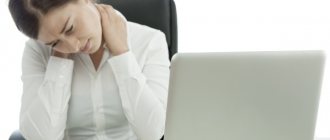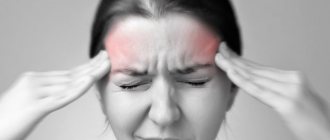Why does the back of my head hurt?
Migraine
With migraine, throbbing pain in the temple or forehead area is most often observed, but in some patients the attack begins with painful sensations in the back of the head, which then spread to half the head.
Characterized by nausea, loss of appetite, photophobia, intolerance to loud sounds, and an increase in symptoms against the background of any physical activity. After the episode ends, pallor, weakness, and yawning are noted. Basilar migraine is manifested by regular paroxysms that occur every few weeks or months. It is preceded by a detailed aura lasting from 5 minutes to 1 hour, including tinnitus, dizziness, ataxia, double vision, dysarthria, and a number of other symptoms. After the aura, a sharp, usually one-sided pain in the back of the head appears, which in 30% of patients is combined with nausea, vomiting, sound and light phobia.
Vascular diseases
Headache with arterial hypertension is dull, pressing or bursting, most often localized in the back of the head. Complemented by dizziness, heaviness, pulsation, tinnitus. Lethargy, weakness, nausea, and palpitations are noted. Along with primary hypertension, the manifestation is characteristic of symptomatic hypertension against the background of the following pathological processes:
- Kidney diseases
: pyelonephritis, glomerulonephritis, hydronephrosis, nephrosclerosis, amyloidosis, polycystic disease, nephroptosis, malformations. - Renovascular pathologies
: aneurysms, dysplasia, thrombosis, atherosclerosis of renal vessels, vasculitis. - CNS lesions
: intracerebral neoplasia, head injury, stroke, encephalitis, meningitis. - Endocrine disorders
: Conn's syndrome, pheochromocytoma, thyrotoxicosis, Itsenko-Cushing's disease, acromegaly. - Hemodynamic disorders
: stenosis of the carotid and vertebrobasilar arteries, sclerosis and coarctation of the aorta, aortic insufficiency. - Side effects of medications
: taking oral contraceptives, indomethacin, levothyroxine, glucocorticoids, mineralocorticoids.
In cerebral atherosclerosis, pain is detected at the initial stage, localized mainly in the back of the head or of a diffuse nature. They appear during physical or emotional stress and are combined with asthenia, sleep disturbances, and memory impairment. Cognitive and neurological disorders then come to the fore.
Spondylogenic vertebrobasilar insufficiency becomes a consequence of compression of the vertebral arteries due to injuries and degenerative diseases of the cervical vertebrae. Sharp pain in the back of the head and neck on one side suddenly occurs after an awkward movement, spreading to the temple, eye and forehead. Complemented by falls, ataxia, pronounced autonomic reactions: pallor, marbling, sweating or dry skin.
Inflammatory processes in the central nervous system
With meningitis, the pain in the back of the head is excruciating, bursting, and radiates along the back of the neck. Appears against the background of intoxication syndrome. Accompanied by an increase in muscle tone, a painful reaction to noise, light, and touch. Children may experience seizures. The clinical picture of encephalitis depends on the type of disease. Typical signs are acute development with severe hyperthermia and cerebral symptoms. Sometimes convulsions, mental disorders, paresis, and hyperkinesis are observed.
Pain in the back of the head
Traumatic injuries
Pain in the back of the head or throughout the head accompanies traumatic brain injuries of any severity. The most common TBI is concussion. Along with pain, victims complain of weakness and nausea. At the time of injury, loss of consciousness or a state of stupor is possible. With brain contusions, clinical manifestations are more pronounced, loss of consciousness is prolonged, and meningeal symptoms are detected. Focal symptoms are possible.
A fracture of the cranial vault in the area of the occipital bone is manifested by sharp, sudden local pain. Then the pain spreads, complemented by manifestations of TBI. A hematoma is detected in the damaged area, and sometimes an indentation is palpated. In victims with wounds to the back of the head, the pain is less intense, from acute to raw, accompanied by heavy bleeding.
Irradiation of pain to the back of the head can be observed with subluxations of the upper cervical vertebrae. The head is in a forced position, and when trying to move, the pain intensifies. The neck muscles are tense. Sometimes dizziness, convulsions, a feeling of goosebumps, and weakness in the limbs are observed.
Damage to the cervical spine
Cervicalgia with a transition to the occipital region is detected with cervical osteochondrosis. The pain is aggravated during movements, so patients keep their head still and turn their whole body. The symptom intensifies against the background of drafts and sleeping in an uncomfortable position. Over time, “lumbago” appears - sharp burning or throbbing pain. Paresthesia and muscle weakness are possible. With an intervertebral hernia, the manifestations are aggravated.
Pulling, shooting, burning pain in the neck and back of the head, combined with sensory disturbances and limitation of movements, are observed in patients with spinal stenosis. With spondylitis against the background of infectious diseases and autoimmune pathologies, pain in the neck, radiating to the back of the head, is combined with signs of an inflammatory process.
Occipital neuralgia
It is provoked by injuries and diseases of the cervical vertebrae, hypothermia, muscle spasms, malformations, abnormalities of the craniovertebral junction, some metabolic disorders, and rheumatic diseases. Sometimes it develops spontaneously (Arnold's neuralgia). It manifests itself as paroxysmal pain in the back of the head (usually one-sided) radiating to the ears and neck. Extremely acute, often painful, unbearable, reminiscent of an electric shock or intense pulsation.
The number of paroxysms with occipital neuralgia varies from one to several dozen per day, the duration of one episode ranges from several seconds to 1-2 minutes. Attacks develop after coughing, sneezing, sudden movements, or occur for no apparent reason. Between paroxysms, symptoms are often absent, sometimes dull aching pain and paresthesia persist.
Muscle damage
Cervical myositis develops after hypothermia or overload. First, local cervicalgia appears. Then the pain spreads to the parietal and occipital regions, the upper back. Intensifies with movement. Sometimes the cause of pain is myalgia. This condition is most often observed when an uncomfortable head position is maintained for a long time, including while working at the computer.
Heat and sunstroke
In victims of sunstroke, the headache is dull, pressing, often more pronounced in the occipital region. Combined with dizziness, drowsiness, nausea, lethargy, hyperthermia. With heatstroke, the pain in the back of the head is initially aching, bursting, and not intense. Gradually intensifies and becomes diffuse. It is accompanied by nausea, increased heart rate and breathing, heaviness in the chest, pale skin, and increased body temperature. Convulsions, psychomotor agitation, delirium, and hallucinations are possible.
Other reasons
The symptom can be detected in the following diseases:
- Anemia
. Pain syndrome is provoked by oxygen starvation of the brain and soft tissues of the neck. - Heart failure.
Systemic circulatory disorders lead to a lack of oxygen in the tissues. - Diabetes.
The symptom is observed in the first stage of hypoglycemic coma. - Erysipelas.
Severe pain is typical for erysipelas of the scalp.
Treatment of headaches with low blood pressure
If the tonometer reading is less than 90/60, then the pressure is low. It is dangerous to increase it sharply with the help of strong medications. Be sure to consult your doctor before taking medications. What you can do at home:
- Drink a cup of strong tea with sugar or coffee.
- Lie in bed with your head slightly lowered and your legs raised.
- Take a tablet of the over-the-counter drug Panadol or Citramon. Citramon contains caffeine, which increases blood pressure, and paracetamol, which relieves pain.
Diagnostics
The nature of the pathology is determined by a neurologist. According to indications, an orthopedist-traumatologist, an infectious disease specialist, and other specialists are involved in the examination. The doctor finds out the time of onset, duration and nature of the pain syndrome, and identifies other symptoms. When collecting anamnesis, the doctor pays attention to possible provoking factors and the presence of chronic diseases.
Examination of the back of the head may indicate external changes (swelling, wounds, abrasions). Palpation sometimes reveals tension, muscle tightness, and enlarged lymph nodes. A neurological examination involves assessing reflexes, muscle strength, various types of sensitivity, and detecting focal disorders. To clarify the diagnosis, the following are prescribed:
- X-ray examination
. Indications for radiography of the skull are fractures of the occipital bone, for radiography of the cervical vertebrae - subluxations, spondylitis, osteochondrosis, hernias. - CT scan.
Allows you to detail the data obtained during radiography. The contrast technique displays changes in blood vessels. - Magnetic resonance imaging.
It visualizes brain tissue well and is used to study their structure, detect tumors, hematomas, areas of degeneration, and other changes. - Ultrasound methods.
Ultrasound scanning and Dopplerography make it possible to assess vascular tone, blood flow speed, and other indicators, and to form a comprehensive picture of the blood supply to the brain. - Electroencephalography.
Performed to assess the functional activity of the brain, determine the severity of cerebral dysfunction due to injuries and certain diseases - Lumbar puncture.
Performed for head injury, meningitis, encephalitis. Confirms the presence of intracranial hypertension, inflammation, bleeding. - Lab tests
. Informative for atherosclerosis, inflammatory and infectious processes, as well as somatic and endocrine diseases that provoke secondary arterial hypertension.
Examination by a neurologist
What to do with fluctuating pressure?
It often happens, especially in older people, that the pressure is either high or low. As soon as you take a pill for the high, it goes down, and you feel completely out of control again. What to do in such cases?
First, you need to remember that low blood pressure is not as dangerous as high blood pressure. With high blood pressure, a complication can be a stroke, and low blood pressure, as a rule, does not threaten anything other than poor health. Therefore, it is necessary to reduce high blood pressure, even if there is a danger of lowering it too much.
Secondly, you should not try too hard to increase low blood pressure, otherwise this may lead to a crisis. The simple home measures listed above are sufficient. If your head hurts very badly, the same Paracetamol will help, which does not affect blood pressure, but perfectly relieves unpleasant symptoms.
To keep your blood pressure stable, you need to lead a healthy lifestyle regardless of age, walk as much as possible and be in the fresh air. As the latest research shows, the best way to prevent blood pressure disorders is moderate physical activity.
And if walking or exercise causes discomfort, treatment by an osteopath can help. Often the reasons why a person is unable to move can be treated with osteopathic methods. Instead of sitting in your apartment drinking handfuls of pills, you can use osteopathy to put your body in order and begin active prevention of cardiovascular diseases.
Treatment
Pre-hospital assistance
Emergency care is necessary for sunstroke and heatstroke. The victim is transferred to a shaded place, clothes are removed if possible, and cold is applied (cool, but not ice compresses) to the forehead, chest, legs, and hands. To prevent dehydration, give water or weak sweet tea. Patients with suspected TBI are kept at rest and placed on their side to prevent aspiration of vomit. In case of spinal injuries, the neck is immobilized with a cotton-gauze collar or improvised means (for example, a folded scarf).
Conservative therapy
The list of therapeutic measures is compiled taking into account the cause of the pain syndrome:
- Migraine
. To relieve paroxysms, analgesics and caffeine-containing drugs are used. Sometimes therapeutic blockades are indicated. For basilar migraine, oxygen inhalation is effective; during the interictal period, sedatives, reflexology, electrosleep, and massage of the cervical-collar area are recommended. - Arterial hypertension
. A special diet is prescribed. Correction of the underlying pathology is carried out. Medicines with antihypertensive effects, diuretics, antiplatelet agents, and adrenergic blockers are used. - Cerebral atherosclerosis
. Therapy includes a low-cholesterol diet, lipid-lowering, vascular agents, antiplatelet agents, and neurometabolites. - Vertebro-basilar syndrome
. Antihypertensive drugs, neuroprotectors, anticoagulants, antiplatelet agents, NSAIDs, and antidepressants are effective. Exercise therapy, post-isometric relaxation, hyperbaric oxygenation, and magnetic laser therapy are performed. - Meningitis, encephalitis
. The basis for the treatment of bacterial inflammatory processes are antibiotics and sulfonamides. For a viral infection, restorative and symptomatic drugs are used, sometimes corticosteroids and diuretics. - Occipital neuralgia
. NSAIDs, muscle relaxants, glucocorticoids, drugs with anticonvulsant effects, B vitamins are indicated. To improve the psycho-emotional state, antidepressants are included in the regimen. - Myositis
. The choice of pharmaceuticals is determined by etiology. For bacterial infections, antibiotics are prescribed, for parasitosis - anthelmintics, for autoimmune processes - glucocorticoids and immunosuppressants.
First aid for high blood pressure
If you have a headache, the first thing you need to do is measure your blood pressure with a tonometer. Its increase to 140/90 or more indicates the likelihood of hypertension and crisis. If this occurs for the first time, you should definitely consult a doctor or call an ambulance. You should not take any medications without examination and prescription from a doctor. To alleviate the condition, you need to lie in a bed with a high pillow, put a cold towel on your head and wait for the doctor. If you have already been prescribed medications for blood pressure, you need to take those that are intended for emergency use. As a rule, it is kapoten or corinfar.
It's all about...
Do you remember your most interesting dream? Maybe you flew or traveled in it. Maybe you returned to childhood: the old yard, friends, swings... In what position did you open your eyes? Each of us has our own favorite sleeping position. Some people need to lie down like a sun, others need to curl up in a ball.
How does all this relate to physiology and health? The correct sleeping position is crucial! It depends on it how healthy your sleep is. The natural position of the spine is what we need to feel “at our best.” And on a fluffy, high pillow, the cervical region is strongly curved.
You will not feel any discomfort in your sleep. Well, you're used to sleeping like that. But the lack of oxygen due to impaired blood flow and muscle tension, which should not exist during a night’s rest, will eventually result in headaches, dizziness, insomnia... In general, you don’t need this. This is why the correct choice of anatomical pillow is so important.
People's Councils
Folk remedies for correcting blood pressure can be considered only at the initial stage of the disease. If the pain is systematic, then consultation with a doctor and drug treatment is required.
For hypertensive patients
To relieve pain in the back of the head with hypertension, tinctures and decoctions of hawthorn, stevia, flax seeds, clover, valerian, and lavender are used. These herbs improve blood circulation and lower blood pressure.
Pre-grated horseradish root infused in water (200g) for 24 hours is also considered a good remedy. By adding the same amount of carrot and beet juice to it, you should take 1 tbsp of the product. half an hour before meals.
For hypotensive patients
For occipital pain due to hypotension, traditional medicine recommends the use of tinctures of Eleutherococcus, Schisandra, and ginseng.
You can take 15 drops of calendula tincture 2 times a day.
A mixture of honey and cranberry juice, taken in equal parts, works well to equalize low blood pressure. The product is taken for 2 weeks, three times a day, 1 tsp.
With ICP
To reduce intracranial pressure and reduce the amount of cerebrospinal fluid, garlic infusions and compresses with mint are used. For mint compress, the raw materials are crushed and boiled for 15 minutes. in 1 l. water, filter, cool. A napkin soaked in the broth is applied to the head and held until it cools completely.
You can prepare and take a mixture of lemon and honey before bed.
To do this, mix the juice of one lemon with honey (5 tablespoons), take 1 tablespoon each. for the night. In addition, it is recommended to increase the consumption of foods rich in potassium. For example, sesame seeds, poppy seeds, kefir, sour cream, yogurt. It is prohibited to visit the bathhouse and sauna.
Choose so choose
Now about what you need to consider when choosing. So as not to complain later that your neck hurts after using an anatomical pillow or that you have a constant headache.
So, the position of the head. The shoulders only touch the edge of the pillow; only the neck and head are located on it. If the model has a bolster and its height matches your shoulder, everything is fine.
A few more “secrets” that everyone should know. The ideal width of bedding, which we have dedicated this article to, is equal to the width of your shoulders. Then it will be as comfortable as possible to sleep.
When deciding on rigidity, experts advise focusing on your favorite position. Softer should be chosen for those who sleep on their stomach, medium-hard for those who sleep on their back, and hard for those who like to sleep on their side.









